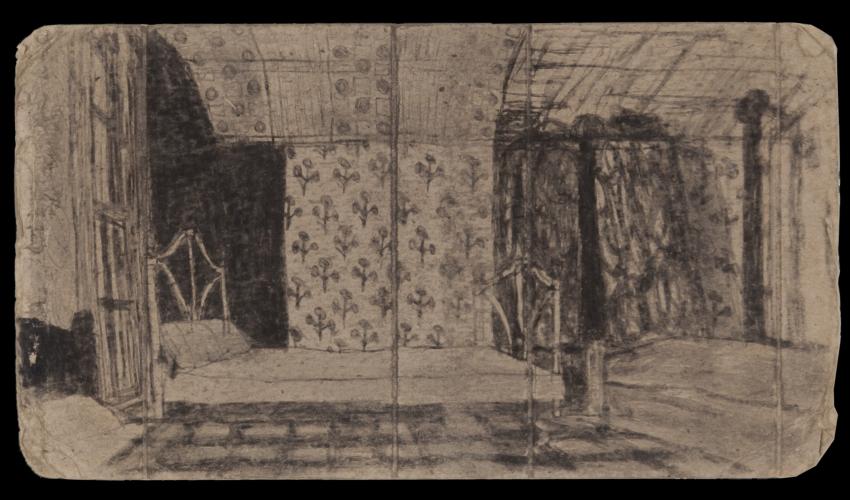
Against type and tradition, the Santa Barbara Museum of Art’s (SBMA) current idea of a “summer blockbuster” ranks among its quietest and more introspective shows in memory, presenting the supremely subtle, fascinating work and life of highly personal artist James Castle as its main summer affair. In the large McCormick Gallery, formerly home to the colorful and big-personality vibrancy of conceptual sculptor Joan Tanner’s Out of Joint exhibition, lights and sensibilities have been turned down to a whisper — a compelling and disarmingly wise whisper.
Never mind the age-old adage “look at the art, not the artist” where Castle is concerned; the very distinctive and nuanced circumstances of his life are critical to understanding the power and essence of his art. The Private Universe of James Castle: Drawings from the William Louis-Dreyfus Foundation and James Castle Collection and Archive succeeds in pulling us into the artist’s self-invented world.
Castle (1899–1977) was born deaf in rural Idaho, before his nurturing family moved to Boise. He was illiterate in the traditional sense but studied imagery in comic books, newspapers, and magazines — as well as images by Old Masters — to inform his self-taught illustrative sensibilities, honing his own private artistic world as an expressive outlet. Material-wise, he mostly used soot from wood-burning stoves mixed with his saliva, often drawn on found paper scraps with Q-tips and sticks to create drawings mostly from his early memories of farm life and interior spaces of his youth.

If the details of Castle’s insular backstory tend to land him in the dodgy realm of the so-called “outsider artist,” his evident and innately sophisticated artistic skills place him in a more refined caliber of image-making.
To wander and gander at the SBMA’s generous selection of Castle’s small, dim-lit creations is to visit another space, time, and intimate artistic worldview. It’s easy to literally get lost in this art, while speculating on the factors that led the artist to think and make art the way only he could.
In the entryway to the McCormick Gallery, a few atypical pieces portray formative and family-related influences in Castle’s life, including “Young James Castle (after a Photograph)” and “Mary Castle in a Rocking Chair.” The inspirational frame widens to include seminal artistic influences, as with the wild, comic-inspired mash-up “Spacecraft with Aliens and Station Wagon,” from the vernacular angle, and thumbnail sketches of paintings by Raphael and Millet from a more art-worldly vantage point.
A series of Farmscapes evoke the adult artist’s lingering memory of the old family farm through the dimming scrim of remembered visions and detailed slices of interior life in old bedrooms, attics, and other spaces drifting into view. Calm, composed interior imagery leads us through his mind/memory filter into an old shed/studio, barn, bedroom, and other not-necessarily dramatic spaces in houses. “View of Parlor” savors the dizzy collision of polka-dotted and otherwise busy wallpaper and carpeting (and ceiling paper?), while “View of Stair Landing” coaxes an almost abstract, spiritual presence from an ostensibly mundane corner of a house. “View into Room with Doorknobs” exemplifies his detailed memory detector, focusing on a minute detail of a room from his past.
Figures do appear, occasionally, though in the facsimile form of cardboard “friends” Castle constructed. We are also privy to the humble house trailer he lived and worked in for the last 15 years of his life, along with such surprisingly moving everyday images as “Landscape with Beehive Boxes,” “View of Porch,” and the swarming warmth of “View of Post Office with Wood Stove” (with the added attraction that such a stove was a supplier of his soot-based art supply needs).
Things turn slightly odd and surreal at times, amid the normally rational remembrances, as with the pictorially playful “Farmscape with Giant Sequoia,” in which a massive, truncated tree trunk inserts itself into an otherwise typical scene down on the farm.
In general, Castle created visual and ambient poetry, marrying form, content, and his fragile medium. SBMA’s exhibition is an inherently introspective variation on the “summer show” theme, luring us inward to appreciate the understated but deep-dish art, while also meditating on the special mind state of the artist behind this private vision.
The Private Universe of James Castle: Drawings from the William Louis-Dreyfus Foundation and James Castle Collection and Archive is on view at Santa Barbara Museum of Art through September 17. See sbma.net




You must be logged in to post a comment.